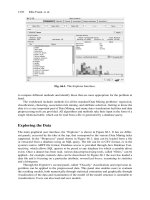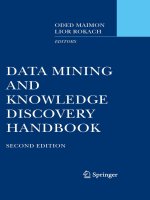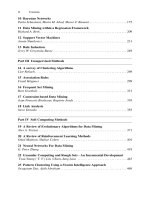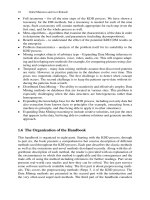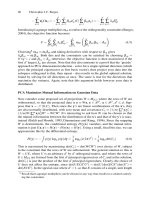Data Mining and Knowledge Discovery Handbook, 2 Edition part 1 pps
Bạn đang xem bản rút gọn của tài liệu. Xem và tải ngay bản đầy đủ của tài liệu tại đây (211.04 KB, 10 trang )
Data Mining and Knowledge Discovery Handbook
Second Edition
Oded Maimon · Lior Rokach
Editors
Data Mining and Knowledge
Discovery Handbook
Second Edition
123
Editors
Prof. Oded Maimon
Tel Aviv University
Dept. Industrial Engineering
69978 Ramat Aviv
Israel
Ben-Gurion University of the Negev
Dept. Information Systems
Engineering
84105 Beer-Sheva
Israel
ISBN 978-0-387-09822-7 e-ISBN 978-0-387-09823-4
DOI 10.1007/978-0-387-09823-4
Springer New York Dordrecht Heidelberg London
c
All rights reserved. This work may not be translated or copied in whole or in part without the written
permission of the publisher (Springer Science+Business Media, LLC, 233 Spring Street, New York,
NY 10013, USA), except for brief excerpts in connection with reviews or scholarly analysis. Use in
connection with any form of information storage and retrieval, electronic adaptation, computer
software, or by similar or dissimilar methodology now known or hereafter developed is forbidden.
The use in this publication of trade names, trademarks, service marks, and similar terms, even if
they are not identified as such, is not to be taken as an expression of opinion as to whether or not
they are subject to proprietary rights.
Printed on acid-free paper
Springer is part of Springer Science+Business Media (www.springer.com)
Springer Science+Business Media, LLC 2005, 2010
Library of Congress Control Number: 2010931143
Dr. Lior Rokach
To my family
– Oded Maimon
To my parents Ines and Avraham
– Lior Rokach
Preface
Knowledge Discovery demonstrates intelligent computing at its best, and is the most
desirable and interesting end-product of Information Technology. To be able to dis-
cover and to extract knowledge from data is a task that many researchers and prac-
titioners are endeavoring to accomplish. There is a lot of hidden knowledge waiting
to be discovered – this is the challenge created by today’s abundance of data.
Knowledge Discovery in Databases (KDD) is the process of identifying valid,
novel, useful, and understandable patterns from large datasets. Data Mining (DM)
is the mathematical core of the KDD process, involving the inferring algorithms
that explore the data, develop mathematical models and discover significant patterns
(implicit or explicit) -which are the essence of useful knowledge. This detailed guide
book covers in a succinct and orderly manner the methods one needs to master in
order to pursue this complex and fascinating area.
Given the fast growing interest in the field, it is not surprising that a variety of
methods are now available to researchers and practitioners. This handbook aims to
organize all major concepts, theories, methodologies, trends, challenges and applica-
tions of Data Mining into a coherent and unified repository. This handbook provides
researchers, scholars, students and professionals with a comprehensive, yet concise
source of reference to Data Mining (and additional selected references for further
studies).
The handbook consists of eight parts, each part consists of several chapters. The
first seven parts present a complete description of different methods used throughout
the KDD process. Each part describes the classic methods, as well as the extensions
and novel methods developed recently. Along with the algorithmic description of
each method, the reader is provided with an explanation of the circumstances in
which this method is applicable, and the consequences and trade-offs incurred by
using that method. The last part surveys software and tools available today.
The first part describes preprocessing methods, such as cleansing, dimension re-
duction, and discretization. The second part covers supervised methods, such as re-
gression, decision trees, Bayesian networks, rule induction and support vector ma-
chines. The third part discusses unsupervised methods, such as clustering, associ-
ation rules, link analysis and visualization. The fourth part covers soft computing
VIII Preface
methods and their application to Data Mining. This part includes chapters about
fuzzy logic, neural networks, and evolutionary algorithms.
Parts five and six present supporting and advanced methods in Data Mining, such
as statistical methods for Data Mining, logics for Data Mining, DM query languages,
text mining, web mining, causal discovery, ensemble methods, and a great deal more.
Part seven provides an in-depth description of Data Mining applications in various
interdisciplinary industries, such as finance, marketing, medicine, biology, engineer-
ing, telecommunications, software, and security.
The motivation: Over the past few years we have presented and written several
scientific papers and research books in this fascinating field. We have also developed
successful methods for very large complex applications in industry, which are in
operation in several enterprises. Thus, we have first hand experience in the needs
of the KDD/DM community in research and practice. This handbook evolved from
these experiences.
The first edition of the handbook, which was published five years ago, was ex-
tremely well received by the data mining research and development communities.
The field of data mining has evolved in several aspects since the first edition. Ad-
vances occurred in areas, such as Multimedia Data Mining, Data Stream Mining,
Spatio-temporal Data Mining, Sequences Analysis, Swarm Intelligence, Multi-label
classification and privacy in data mining. In addition new applications and software
tools become available. We received many requests to include the new advances in
the field in a second edition of the handbook. About half of the book is new in this
edition. This second edition aims to refresh the previous material in the fundamental
areas, and to present new findings in the field. The new advances occurred mainly in
three dimensions: new methods, new applications and new data types, which can be
handled by new and modified advanced data mining methods.
We would like to thank all authors for their valuable contributions. We would
like to express our special thanks to Susan Lagerstrom-Fife of Springer for working
closely with us during the production of this book.
Tel-Aviv, Israel Oded Maimon
Beer-Sheva, Israel Lior Rokach
April 2010
Contents
1 Introduction to Knowledge Discovery and Data Mining
Oded Maimon, Lior Rokach 1
Part I Preprocessing Methods
2 Data Cleansing: A Prelude to Knowledge Discovery
Jonathan I. Maletic, Andrian Marcus 19
3 Handling Missing Attribute Values
Jerzy W. Grzymala-Busse, Witold J. Grzymala-Busse 33
4 Geometric Methods for Feature Extraction and Dimensional
Reduction - A Guided Tour
Christopher J.C. Burges 53
5 Dimension Reduction and Feature Selection
Barak Chizi, Oded Maimon 83
6 Discretization Methods
Ying Yang, Geoffrey I. Webb, Xindong Wu 101
7 Outlier Detection
Irad Ben-Gal 117
Part II Supervised Methods
8 Supervised Learning
Lior Rokach, Oded Maimon 133
9 Classification Trees
Lior Rokach, Oded Maimon 149
